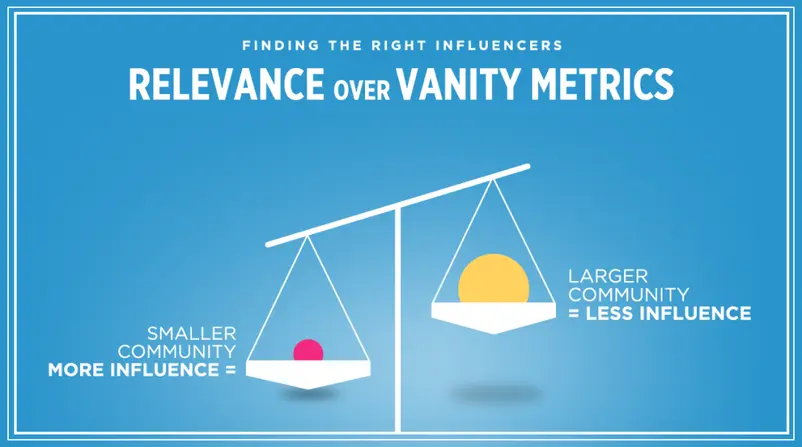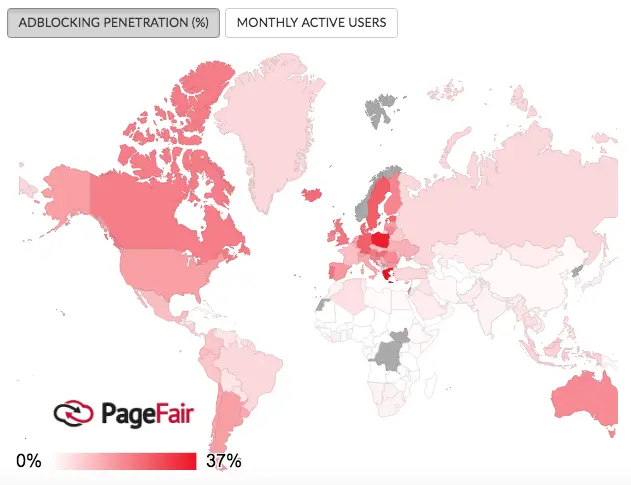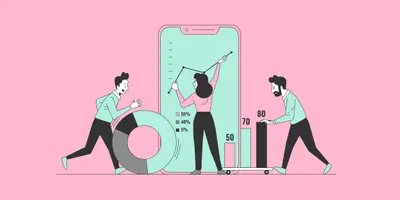We live in a world that is awash with advertising. Consumers are marketed to at nearly every turn throughout their day. It’s estimated that people see up to 5,000 ads during their waking hours, a rate of one every 11.5 seconds. It’s a number that, in practice, overwhelms the senses—and the target audience has grown very adept at tuning out all the background noise. To put that another way: nobody reads ads.
5 Influencer Marketing Insights You Need to Know:
- 1. You are no longer a marketer, you’re a relationship manager.
- 2. Vanity metrics are only indicators of a campaign’s potential success—not the success itself.
- 3. A bigger audience isn’t necessarily the best option.
- 4. Influencer Marketing doesn’t begin or end with any specific campaign.
- 5. Product to Platform is the new P2P
Nowhere is this more quantifiable than online. With print or television ads, you might have some idea as to their reach, but it’s very hard to draw a direct line from the ad to any consumer action. Online, it’s a different story—one that doesn’t have a very happy ending for marketers. Look at these statistics regarding traditional “display advertising” (like banner and sidebar ads on a website):
- According to Google’s Display Benchmark Tools, the world-wide average click-through rate (CTR) of all ads, across all formats and placements, is sitting at 0.18% as of this writing.
- By 2015, there were 198 million users worldwide actively using ad blocking software.
- When asked, only 14% of users can remember the last ad they saw online. Of those people, 8% remember what the company or product was, while just 2.8% of them thought the ad was relevant.
- In a report from the Pew Research Center, 28% of people surveyed said they try to hide their online activity from advertisers. The only group less trusted? Criminals and hackers (33% of respondents said they were a concern).
All of these statistics on their own should be pretty alarming if you’re a marketer, but together they paint a grim picture. Users proactively take steps to block display ads, ignore most of the ones that make it to their screen, can’t remember the ones they might have looked at, find the ads irrelevant if they do remember them, and—most damning—don’t trust the people who are crafting these messages.
The one thing all these ads have in common is their adherence to the time-worn advertising techniques. Online display ads are nothing more than digital versions of their print and broadcast counterparts. The only thing that makes them unique to the modern era is the delivery medium. Otherwise, they use all the same tactics that people have been effectively tuning out for years.
These are the challenges that sparked the evolution of Influencer Marketing, the basic premise of which doesn’t just circumvent these obstacles—it comes at them directly and renders them meaningless. That is, if you do it right.
Some marketers hear about IM as the Next Big Thing, learn the basics, and then make the mistake of applying traditional marketing techniques to an influencer campaign. Unfortunately, conventional marketing wisdom doesn’t apply here, and can even be a detriment to the process. If you’re looking to up your Influencer Marketing game, it’s time to let go of your attachments to the way things were—and start learning what those who’ve been successful at it have to say.
1. You are no longer a marketer, you’re a relationship manager.
It’s tempting to view the brand/influencer relationship in more old-school terms: companies would use celebrities to hawk their wares, celebrities would use companies for money and free stuff. But this isn't how Influencer Marketing works. Sure, there’s the instant cachet of having a recognisable name doing some of the heavy lifting for you, but influencers aren’t people looking for a quick payday from businesses. And remember, their influence pre-dates your involvement with them. They’ve spent time building up a following of people who want to hear what they have to say, precisely because they already have something to say. They aren’t looking for you, and don’t need whatever “opportunity” you can provide them. If they’re looking for a big payout, there are any number of ways they can monetise their popularity that don’t include getting in bed with a brand looking for a spokesperson.
This is why—when you’re eyeing potential influencers, or keeping the lines open with the ones who already work with you—it's important to manage the relationship between brand and influencer. An influencer gains credibility by fostering trust in her audience over a period of time, while companies looking to market their products are often on the hunt for a quick hit. When brands are looking to work with an influencer, it’s her audience they’re after—and she knows this. She will understandably be protective of those people whose trust and loyalty she’s cultivated.
Brian Solis, Principal Analyst for the Altimeter Group, describes the currency of this relationship as “social capital,” and it’s a marketer’s job to make sure a client doesn’t spend too much of it. He went on to say,
It starts with understanding value, and that takes understanding what’s important to people and why influencers are appreciated by the communities in which they influence.”
The only way to understand that is to start researching, and participating in, the communities that evolved around them. You would be missing the mark by urging a high-end clothing company, for example, to work with an influencer doling out thrift store fashion expertise. That just isn’t of value to her audience, and could end up violating the trust she’s built with them.
When you get it right, though—that is, when you don’t overspend the social capital—the reward can be a customer who’s as loyal to a brand as he is to the influencer. For a recent study, 51% of marketers surveyed said they acquired better customers through Influencer Marketing.
2. Vanity metrics are only indicators of a campaign’s potential success—not the success itself.

Source: medium.com
It’s easy to get caught up in the numbers game of online marketing, talking about likes and shares. But what does these ultimately mean? Nothing.
Nothing concrete, anyway: they are good indicators that you’re reaching a broad audience. As part of an Influencer Marketing campaign, these metrics can even come close to quantifying what that influence is getting you. But at the end of any campaign, shouldn't you have more to show for your efforts than a Powerpoint slide deck detailing how many people liked it?
The goal of any content marketing campaign, whether it involves an influencer or not, is to demonstrate and provide value to your audience. Michael Brennan, the CEO of Marketing Insider Group, advises defining a specific and customer-focused mission to any campaign:
When the content a brand publishes is focused on customer value, then they attract the right people, and achieve brand engagement they would have never otherwise seen.”
“Customer value” is a nebulous term. In some cases, it could mean providing something of actual benefit to the customer. In others, it could mean placing value on the customer herself, encouraging her to become an active part of the campaign. In either case, the goal is to forge a connection with the audience by placing the customer—not the product—front and center. Influencers are especially effective in this regard. First, their already-established credibility gives a brand a headstart in driving engagement. Second, because the influencer is the gatekeeper of an active community of followers, it’s more likely that a campaign will have more measurable engagement beyond a like or share.
A case in point: fashion giant Calvin Klein’s “#mycalvins” campaign, which debuted in February 2014 and is still going strong. No stranger to provocative advertising, the company decided to get its fans involved, inviting users to submit their own (possibly NSFW) photos with the tagline prompt, “I ________ in #mycalvins.” The company enlisted the help of 600 influencers worldwide, collaborating with them to fill in that blank and encourage their followers to do the same. The results?
- A global reach of 469 million people, with 23.5 million fan interactions
- CK, already a household name with millions of social followers, still increased their social fanbases significantly: by 2.2 million, 1.8 million, and 1 million people on Facebook, Instagram, and Twitter, respectively
- 100,000 user submissions in the first year, and the launch of a microsite dedicated to showcasing the best of them
You can do a search on this campaign to find out more, and you’ll notice that anything written about it does not include any references to how many likes or shares the posts received. But you’ll definitely learn how CK sold out of all its women’s underwear styles in the wake of the campaign.
3. A bigger audience isn’t necessarily the best option.
When it comes to finding the right influencers to match with a brand, it’s not the size of their audience that matters. In fact, as the number of followers goes up the likelihood of audience engagement actually comes down. This makes a lot of logical sense: it’s hard for a user to feel a connection to someone they follow when they’re a face in a 1,000,000+ crowd.
There’s data that bears out this thesis, too: on Instagram, in a review of over five million posts, the people over at Markerly found that users with around 1,000 followers or less see an 8% like rate on posts. Yes, the previous section noted that likes don’t matter. And they don’t, in terms of the success of a campaign. But as the bare minimum of engagement from a user, the social like is a good indication of the engagement ceiling—where you can expect interactions to max out. And those interactions decrease as a given follower-base gets larger.
At 1,000 to 10,000 users, the number drops to 4%. This trend continues all the way down the line: influencers with more than 10 million followers see their like rates drop to about 1.6%. Of course, that small percentage is still 160,000 users, but there are larger costs (in effort and money) involved with getting someone that popular to work with you—perhaps at the expense of being able to work with several smaller names simultaneously.
Sarah Ware, the CEO of Markerly, offers some nice anecdotal evidence to go along with the statistics. Working with a weight-loss tea company, Markerly recruited several Kardashians for an Instagram campaign and, yes, they saw good results. But they also brought in another 30 - 40 micro-influencers—at 10K to 100K followers each—and saw higher levels of conversion that, all told, more than kept up with the Kardashians.
4. Influencer Marketing doesn’t begin or end with any specific campaign.
Visualize your influencer marketing efforts as a computer network, connecting a large number of devices through which users can access services. Those services are the various forms of engaging and useful content you create as part of your marketing campaigns. The users who access these services are the members of your influencers’ audience, and the devices that enable access are the influencers themselves. You and your marketing firm are the cables and hardware working behind the scenes to make sure everything is connected and operational.
Any network administrator will tell you that your job isn’t done when you successfully deploy a device into the network. You still need to monitor it, and apply patches and updates as necessary. This kind of proactive maintenance is the best way to ensure the device continues to serve its particular function to your network. It’s the same with influencers. All the work you did to establish the connection doesn't stop once you've brought them online. That means you’re always marketing to them—preferably many of them at the same time. Engaging with them and their audience—without it being part of a pitch—is crucial to developing and maintaining trust and connections. You’ll spend a big chunk of your day making the rounds on social media, checking in with each of your influencers’ accounts, liking and commenting and just generally being a part of their community. This includes influencers you’ve identified as potential matches to work with and haven’t even approached yet with any specific proposal or idea.
Also, as with any network, the fact that it’s working well today is no excuse not to try to improve and expand on it. In the IT world, that means staying current with hardware and software trends, to make sure you’re not falling behind and putting your network at risk. Again, the same goes with influencer marketing. When you’re not busy interacting with all the influencers you have or might like to have worked with (your current network), you’ll spend another large chunk of time looking for the Next Big Things you haven’t heard of yet. Influencers are everywhere, and new ones are made everyday: finding those who are on their way up in terms of building a following is key to future success.
To do that is easier said than done, though. You’re not the only one looking for that Next Big Thing, so you’ll want to get a little more precise about where you find yours. It’s not enough to see that a prospect has a few thousand followers and high levels of engagement with her community. “It’s important to look beyond the usual suspects,” warns Jason Miller, the Group Manager of Content Marketing at LinkedIn Marketing solutions. He goes on to advise,
Comb over the agendas of the most important conferences in your space and look for the new speakers on the scene who are making waves, search on your topic for up and coming bloggers who have a unique point of view. THIS is where the opportunity is.”
All of this is done in service of making your influencer network robust, resilient, and adaptable, ready to connect with other networks. Which brings us to the next insight.
5. Product to Platform is the new P2P
Let’s take the analogy one step further: the people who you reach with content—your network’s end users—are members of an entirely different network, a social one. That is, they’re each connected to their friends, family, co-workers, and so on down the line through their social accounts. All of these are potential connections you can make, and it’s important that you try to make them through the right platforms. With actual peer to peer networking, communication is established through a mutually agreed upon protocol—a kind of language both sides speak. Here the protocol is the social platform you’re communicating through, and you need to speak the language of your intended audience. The product needs to be aligned with the platform.
Here’s what that means in practice:
In trying to market its city to a millennial audience, the Las Vegas Convention and Visitors Authority (LVCVA) aimed right for their digital hearts by launching its own channel on Snapchat. In true Vegas style, the city went big for the launch, recruiting the so-called “King of Snapchat” DJ Khaled to spend a weekend posting his experiences there—the food, the drinks, the entertainment, including his own performance at the Marquee Night Club.
The promotion worked: in its first 48 hours, the Las Vegas Snapchat channel had over 400,000 views and gained more than 25,000 followers.
The campaign succeeded precisely because of the affinity between the product and platform. The product is the city of Las Vegas itself, and the kinds of experiences it offers. Rob Dondero, the Executive Vice President of the agency charged with marketing the Snapchat launch (R&R Partners), said as much:
We have to market the destination based on the products that are offered. And if you look at the products that are being offered by the hotels, especially in the DJ world, the day club world, even the food and entertainment side, it does skew young."
With this in mind, Snapchat was a no-brainer. 60% of its users are under 25, and nearly two-thirds of that group are in the hard-partying 18-24 demographic that Las Vegas was going for.
But this is only part of what it means to align the product with the platform. Las Vegas could have gone with Instagram, which has a demographic breakdown similar to Snapchat's. 90% of its users under the age of 35. But Snapchat seemed a more appropriate medium for the message. Cathy Tull, the Senior Vice President of Marketing for the LVCVA, explained:
It works well with our what-happens-here-stays-here mentality, because snaps are only available for a limited amount of time."
Finally, to fully understand the importance of matching the product to a platform, think of this exact same campaign of posts—featuring parties, indulgence, and carefree living—unfolding on the pages of LinkedIn. It just doesn’t work.
As you can see, the approach to Influencer Marketing turns the old school methods on their respective heads. You don’t spend a lot of time directly pitching a brand or product itself. You don’t market to the people you want as your customers. Your best options for spokespeople (for lack of a better word) aren’t necessarily going to be the most famous. You won’t succeed just because you’re reaching millions of people across different platforms. That this is new territory shouldn’t discourage you, though. It isn’t uncharted, and with these insights you can better prepare yourself to find your way.






